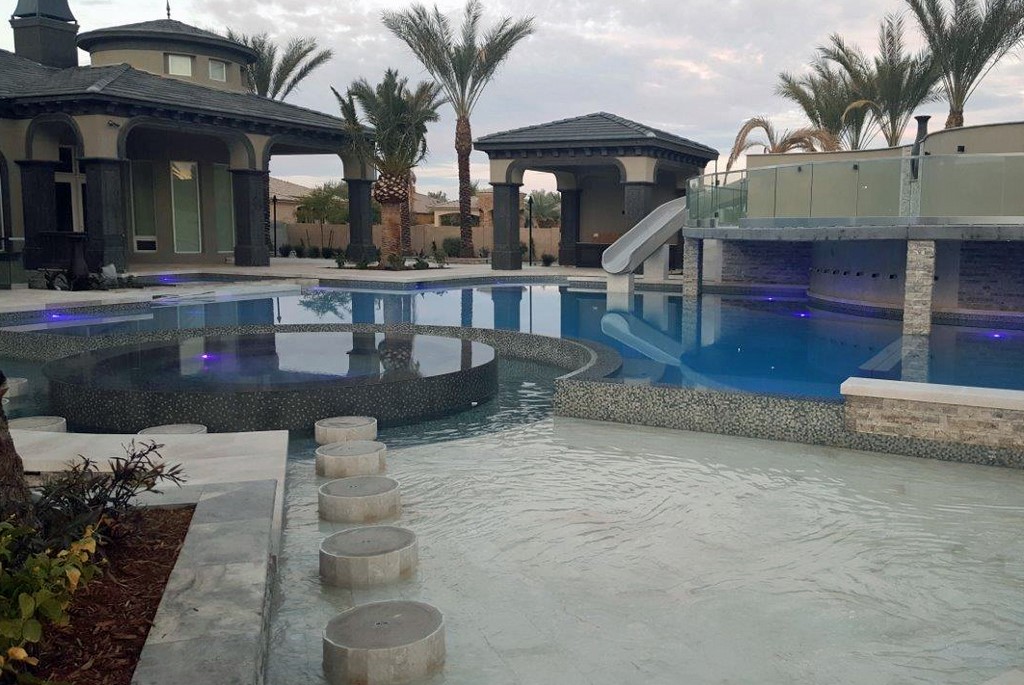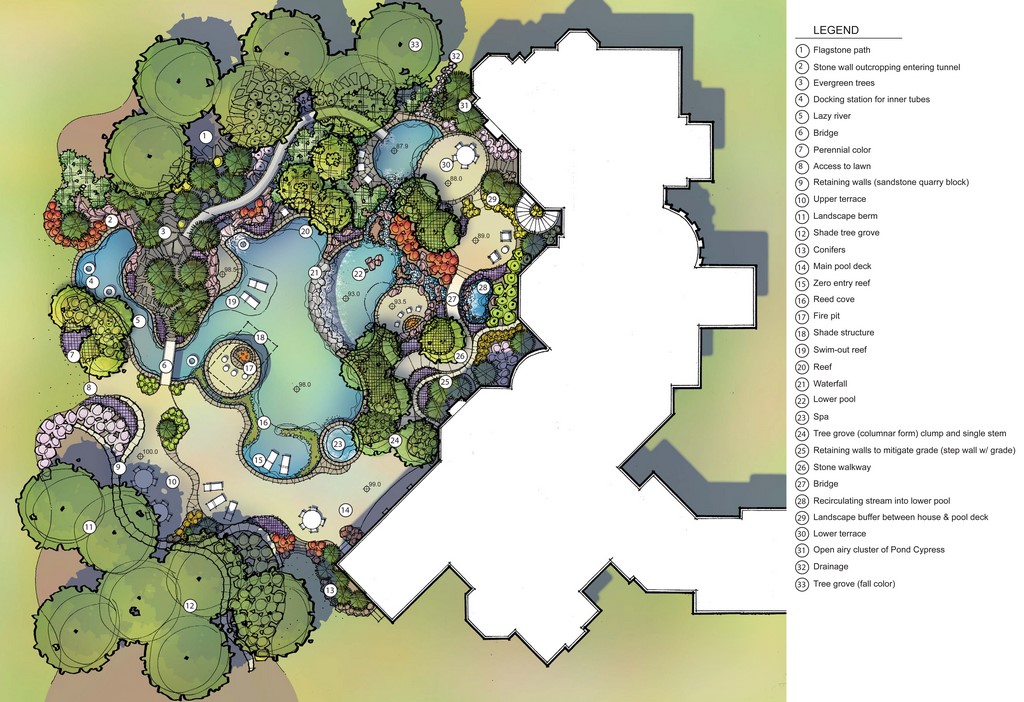A Different Drum

This is a story about possibilities pulled within reach by modern technology.
It all started early in 2015, when one of us talked with a friend about the benefits of belonging to a group of like-minded professionals who get together a couple times a year to talk shop, exchange ideas and generally build the kind of camaraderie that’s hard to develop if all you do is take classes and see your peers once a year at trade shows.
Before that conversation took place, the three of us had shared an observation that a huge number of markets across the country were being under-served by upper-echelon designers. Many of those markets had great home builders and clients who had high ambitions, but they weren’t being matched by professionals capable of delivering watershapes at their level.
Putting it all together, the three of us eventually linked the camaraderie we perceived in professional associations with the gaps we perceived in the marketplace – and Tributary was born.
EARLY AMBITIONS
Even at the discussion stage, we knew that the business alliance we were proposing was quite a stretch beyond the usual. After all, talented designers – and we all consider ourselves to fit within that category – don’t tend to play well together when it comes to open creative collaboration, particularly not on a repeated, project-by-project basis.
But the three of us saw our skills as being more complementary than interwoven: One of us is a landscape contractor, another is a landscape architect and the third is a pool builder. We’ll concede that this is a narrow sort of diversity, but it was enough to encourage us to keep exploring ways we could combine forces so that our collective efforts would add up to more than any of us could accomplish alone.
And we kept at it, because we all shared the same goal: to design the best possible watershapes and backyard environments for ambitious clients, no matter where they happened to live.
| This is a project that’s well under way in Beverly Hills, Calif. In this case, we all played roles, but one of us clicked unusually well with the client and he’s run point from the start. It hasn’t hurt that we found a great contractor in David Penton of Fluid Dynamics Pool and Spa (Fullerton, Calif.). |
In thinking things through, we immediately recognized a whole raft of logistical issues we’d have to consider. How would we organize our business? How could we, mostly working remote from project locations, be sure we could carefully evaluate sites, the client’s tastes and all of the other design drivers that are part of modern watershaping? How could we go past simply reassuring our clients and enter into these projects just as well prepared as if we all worked in the same office and the project was right down the street?
Those are big questions, and we saw clearly that everything we’d be doing would have to be weighed and discussed on a case-by-case basis. We also saw that while it might be advantageous if we could all see the site, we appreciated the fact that most budgets wouldn’t allow it and that, at root, we had to trust each other to get the job done even if just one of us ever managed to see the site.
| Here’s the plan for a project at a private residence in Kansas. Our usual division of labor has one of us handling the design, another tackling the hydraulics and the third dealing with site issues, from drainage and decks to features beyond the water. It’s a flexible arrangement, however, and we will take different roles depending on the project, its location and who’s running point with the client. |
We also perceived that there were factors here that went far beyond a travel budget. There are regional styles to be evaluated, local aesthetic needs to be considered and myriad factors related to material sourcing, subcontractor resources, local codes – the gamut of issues that face any designer (or builder, for that matter) who works away from a familiar home base.
We know we have to be careful and considerate on a number of unusual levels, but we also figured that we have enough collective experience that we could overcome any obstacles that presented themselves. In other words, if we focused on the tasks at hand and positioned ourselves to communicate effectively with each other and with the clients, there really wasn’t anything standing in our way.
And then there was what we saw as our greatest asset: The fact is that we live at a time when computers and Internet technologies make it possible for us to confer and collaborate as though we were all in the same space. Moreover, we all share an expertise with Pool Studio, a digital design system produced by Structure Studios (Henderson, Nev.): We were speaking the same language on so many levels that it kept making more and more sense to keep moving forward.
MEASURED DIVERSITY
One of the advantages of being geographically diverse (the three of us currently have offices in Georgia, Tennessee, Kansas and Arizona) is that we cover lots of ground with respect to knowledge of regional markets and styles. But we’re determined not to become “regional specialists” in any sense of the term: Instead, we’ll divide responsibility among our offices so that we’ll all be intimately involved with our projects as they progress.
As an example, one office might focus in one instance on hydraulics and system development, another might tend to the preparation of construction documents and another might spearhead the design effort. We all have those capabilities, and by rotating functions and looking at projects individually rather than as cookie-cutter exercises, we’ll be playing to our strengths in ways that exceed what we might be capable of individually. Better yet, we’ll be learning from each other in ways that will benefit not only Tributary, but also our own companies.
Even though we might have ambitions to be known as the Three Musketeers of Swimming Pools, we’re aware that there are important ways in which one of us, no matter who it is, must take the lead – especially when it comes to the details of working with a client. In fact, once our processes start internally, only one of us will ever be in direct contact with the homeowner.
| In addition to Pool Studio, which we all see as an indispensible tool that is essential to making our business model work, we’ve also started using three-dimension printing as another presentation tool. And again, this is a system where the output is essentially digital and can be generated wherever it happens to be needed or desired. |
As we consider these practicalities, we keep falling back on the advantages we’re already seeing in a three-brained approach to the business. Yes, one of us will take the lead from the very start – and none of us will suffer if our clients assume that the project lead is our venture’s main person. But we see so much potential in combining resources, knowledge bases, staff capabilities and our own backgrounds that we know, deep down, that what we produce in these remote locations – and they will mostly be remote locations beyond our usual working ranges – will be better than any one of us could pull off alone.
This is actually one of the reasons why we’re maintaining our own operations alongside this new venture: We’re all well-established where we live and have advantages that a combination of forces couldn’t match, so we’ll all keep that going. But once we’re on the road? That’s a different story.
Obviously, much of this depends on the trust we have in each other based on having been both professional acquaintances and good friends for a long time. Just one of us makes final decisions with the homeowner, and we intend to operate on a level at which ego won’t interfere with moving forward. On that level, communication is key – and we know it.
TEAMWORK PLUS
Structured as we are, we accept the fact that we need to be very, very good at working as a team. We also know that we’ll have to be flexible in ways that we wouldn’t ever have considered until the values driving each individual project are defined.
At this point, our role is limited to project design and provision of construction documentation, but we already know that we must be open to the possible need to take a more active role in the construction process. We won’t be sending in crews, but we might, for example, act as the client’s agent in reviewing and negotiating bids from local contractors – or come in for periodic site visits throughout the construction process.
| We’re operating under the assumption that, together, we can tackle projects of any size in any location where the clients agree with us that our three-heads-is-better-than-one approach makes sense. This Arizona project, for example, involved an insane level of detail: We parceled out responsibility in ways that made sense to all of us – and the result speaks for itself. |
To make this all work, we set up Tributary as a separate entity for which our individual companies provide services. The nature of our participation will, as with all other things, be determined on a project-by-project basis – meaning we have no set formulas for allocating time or resources and know that it will vary dramatically from job to job.
At this point, we already have a handful of projects to show for our collaboration. One is a pool in Central America, which is about as remote as can be from our comfortable home markets; others include those highlighted in the photo galleries and captions that appear throughout this article. We’re pleased by the vast potential of what we’re pursuing and the level of service we can deliver to ambitious clients wherever they may be.
It’s a new world, and we’re ready to face it, side by side by side.
Jeromey Naugle is the owner and chief “paradise expert” at Premier Paradise, a design/build firm he started in Phoenix, Ariz., in 2009. With more than 15 years’ experience in designing, building and maintaining watershapes and more than 10 as a digital designer, Naugle participates in the Genesis 3 schools as well as Pool Studio educational programs. He may be reached at jeromey@premierparadise.net. Kurt Kraisinger is a landscape architect with more than 20 years’ experience in design and consulting. In 2009, he founded Lorax Design Group with a goal of creating memorable spaces that allow people to engage in their surroundings. He received his degree in landscape architecture and urban planning from Kansas State University and participates in Genesis 3’s programs. He may be reached at kkraisinger@loraxdesigngroup.com. Shane LeBlanc has owned and operated Selective Designs, an Atlanta-based design/build firm specializing in custom pools, landscapes and gardens, since founding it in 2002. Building on a foundation of experience in landscape design, turf care, tree farming and nursery management, he has a degree in business administration and participates in the Genesis 3 educational system. He may be reached at shane@selectivedesigns.com




















